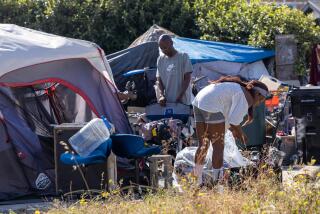City Workers Hit Streets in Search of ‘Lost’ Households : Census: Official teams are looking for residents missed in the 1990 count. At stake are federal aid dollars and political clout.
- Share via
Los Angeles city officials have embarked on an effort to check preliminary U.S. Census figures released this week, pounding the pavement and punching their computer keys in a multilevel effort to challenge the federal data.
Anticipating that the city’s population was significantly undercounted, the city actually began dispatching workers across Los Angeles last week in the first phase of a three-week deployment.
By this afternoon, city sanitation workers will have completed a count of households on 400 randomly selected blocks in order to make a comparison with the new federal figures.
And on Wednesday, a team of police, firefighters and Department of Water and Power employees will be sent out to several hundred additional blocks. They will investigate major discrepancies that have turned up between the federal census data and a city computer-generated list of households compiled from building permits, electric meters and voterregistration files.
“If the city is undercounted, it means a loss of state and federal funds based on population and a loss of political representation,” said Deputy City Atty. Jessica Heinz, who is heading the city’s census verification efforts. “I think there has been a bad undercount.”
Preliminary census figures released Monday showed 3.42 million Los Angeles residents, up 15% from 1980’s final figure of 2.96 million. The data also showed Los Angeles to have 1.29 million dwelling units.
On Wednesday, Mayor Tom Bradley acknowledged that the federal count closely paralleled city projections, but he nonetheless called for a reassessment of homeless and minority populations,which he asserted had been significantly undercounted.
Gregory Lipton, a demographer for the city’s Community Development Department, explained that a “superficial” look at the federal data shows reasonable results. “But current estimates of population are based on the 1980 census, which was undercounted, so we’re adding onto a base flawed by 4.7%,” Lipton said.
In embarking on its survey this week, the Sanitation Bureau is preparing a record of addresses where the city collects trash on the 400 randomly chosen blocks. The completed list will be compared next week to the Census Bureau’s list of households surveyed. “We believe we will be able from a statistically reliable sample to make a general statement on how the block count went throughout the city,” Heinz said.
Next week’s study will zero in on specific blocks in which discrepancies exist between the federal data and a city computer run. In January, when the Census Bureau offered a pre-census local review of addresses to which it planned to mail its forms, city officials discovered 2,000 blocks with more than five discrepancies apiece, Heinz noted.
By uncovering flaws in the federal data, the city would bolster its case for a reassessment. If the city can prove its population is higher, it could reap millions of dollars a year in additional state tax revenues and aid for the poor and homeless.
The federal government typically seeks to avoid recounts because of the steep cost.
More to Read
Sign up for Essential California
The most important California stories and recommendations in your inbox every morning.
You may occasionally receive promotional content from the Los Angeles Times.










